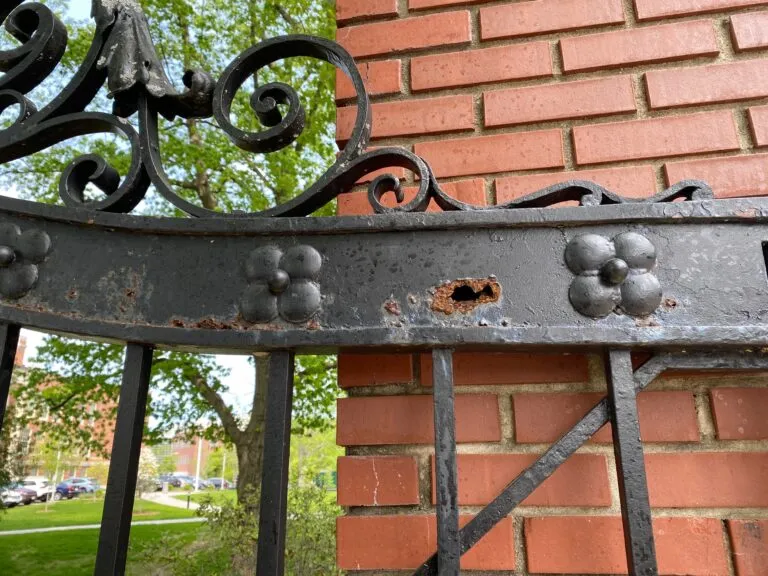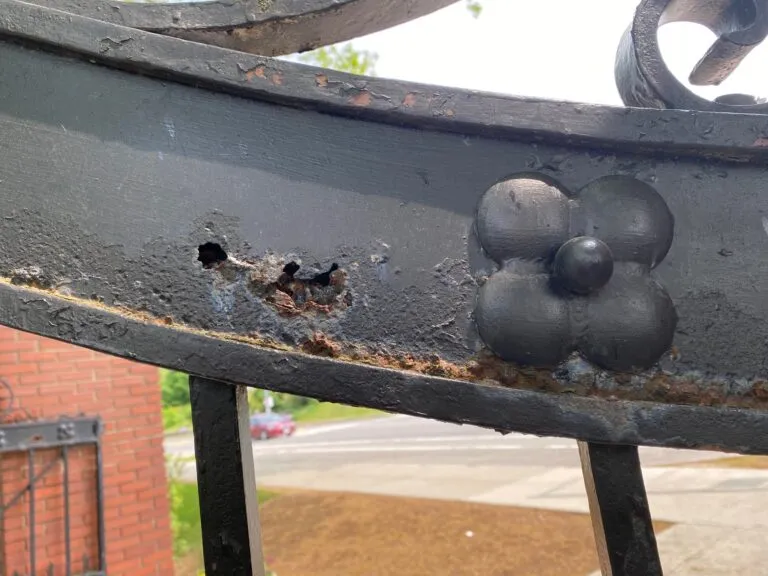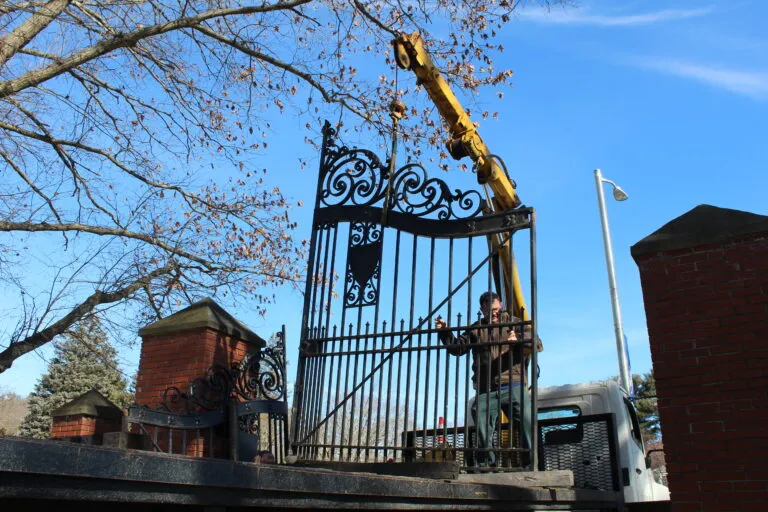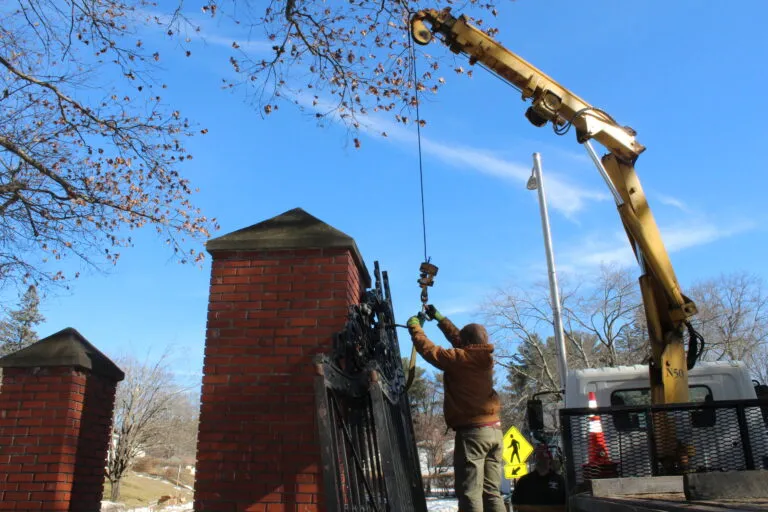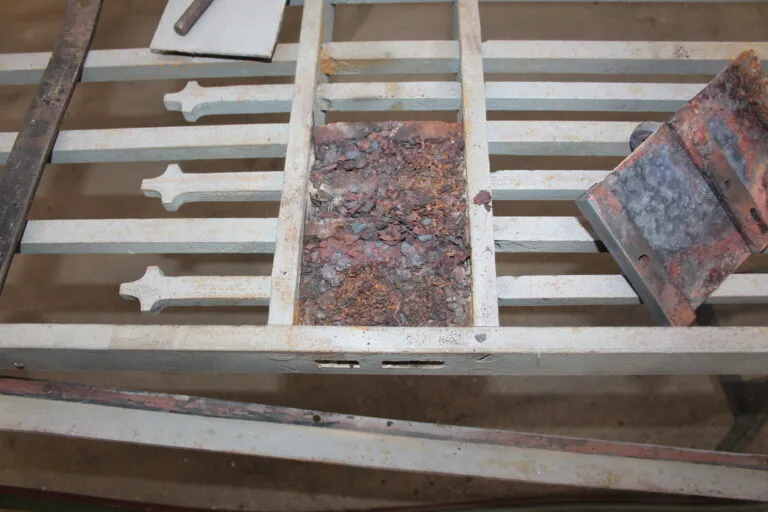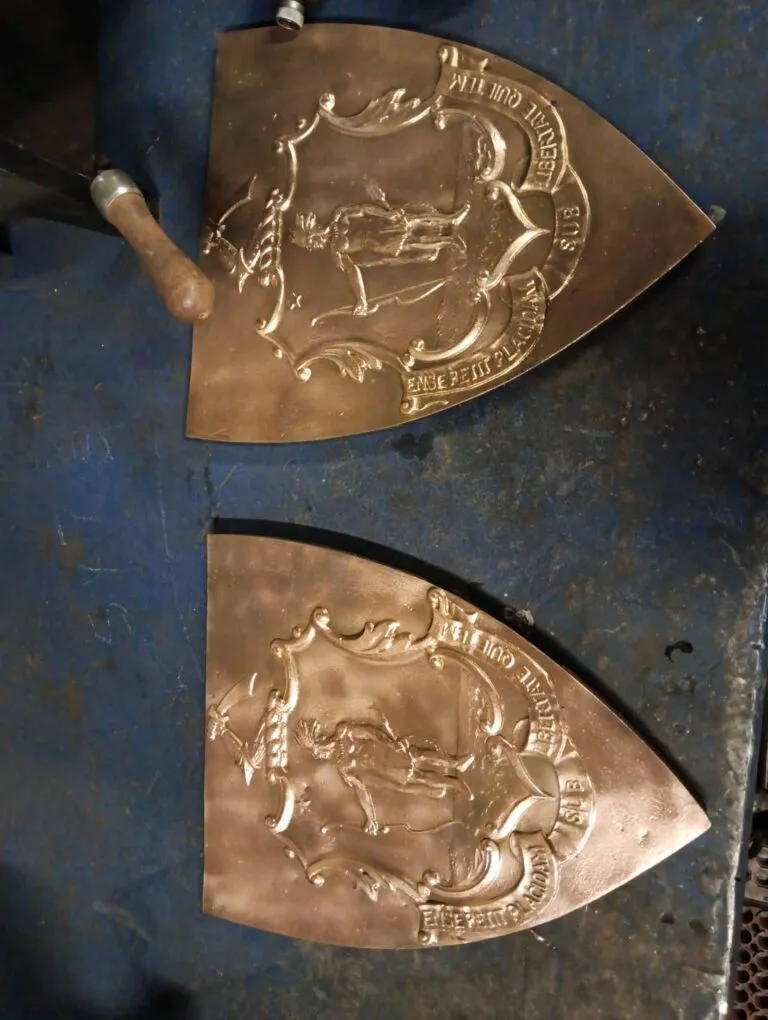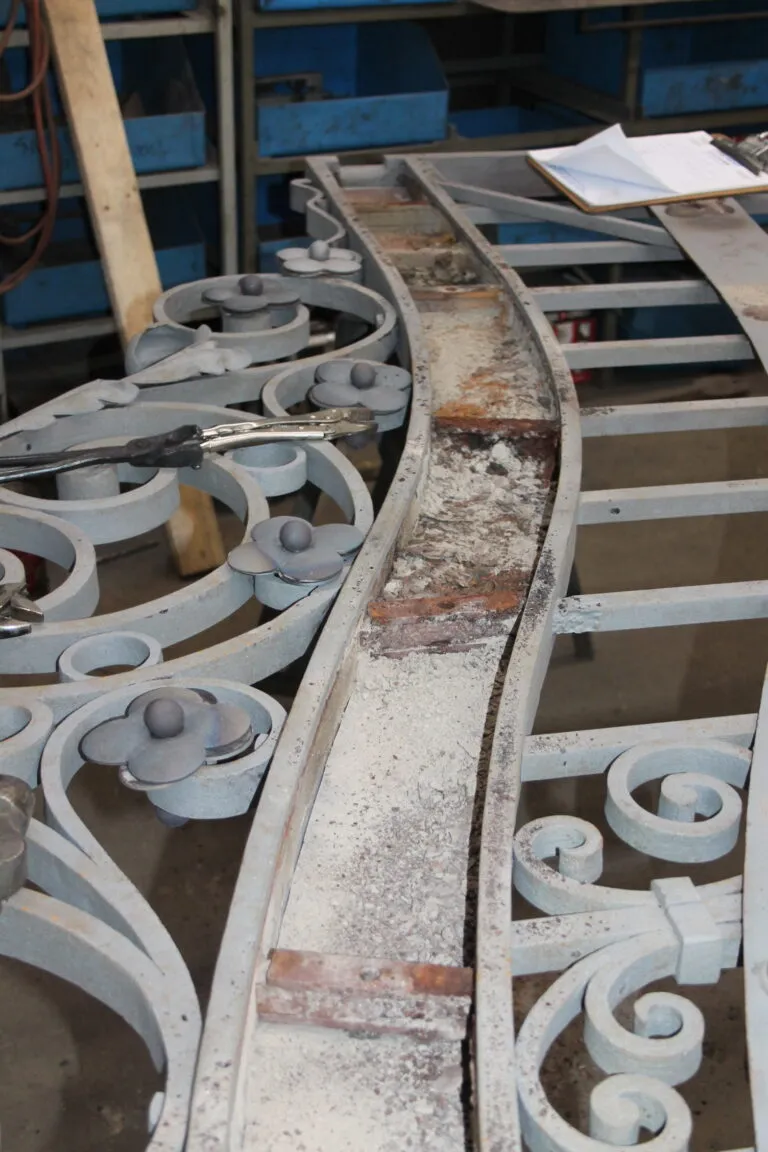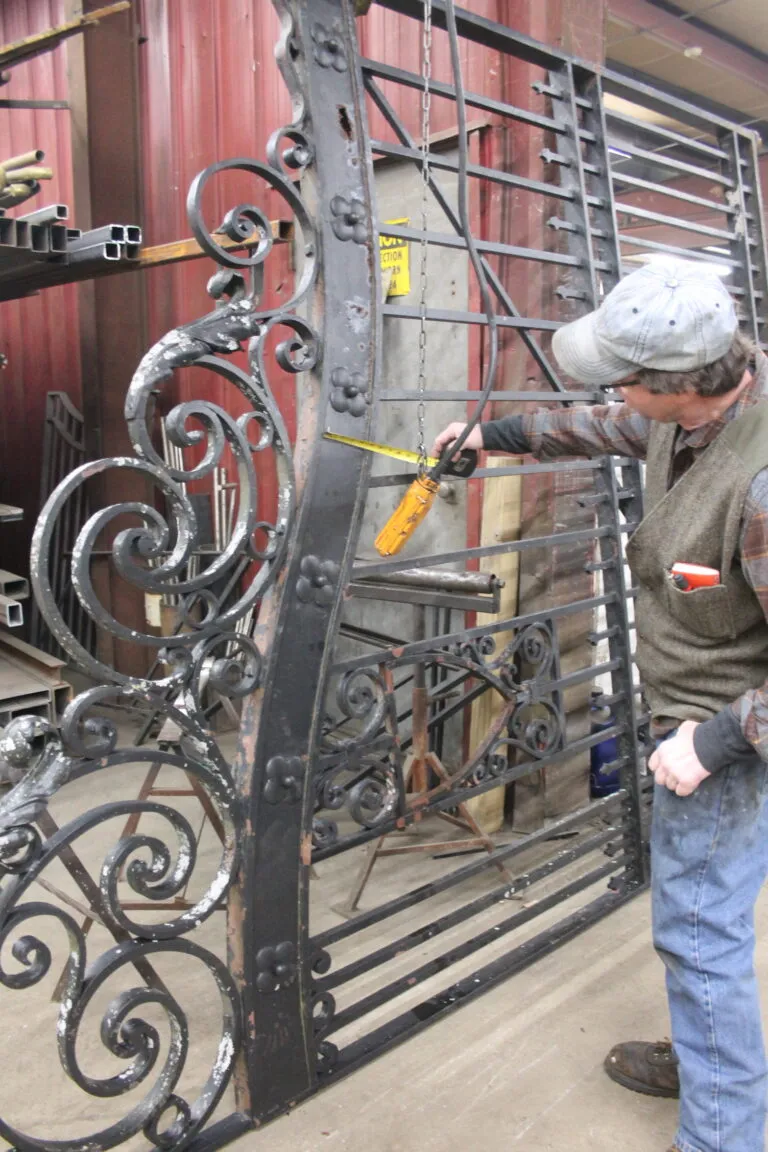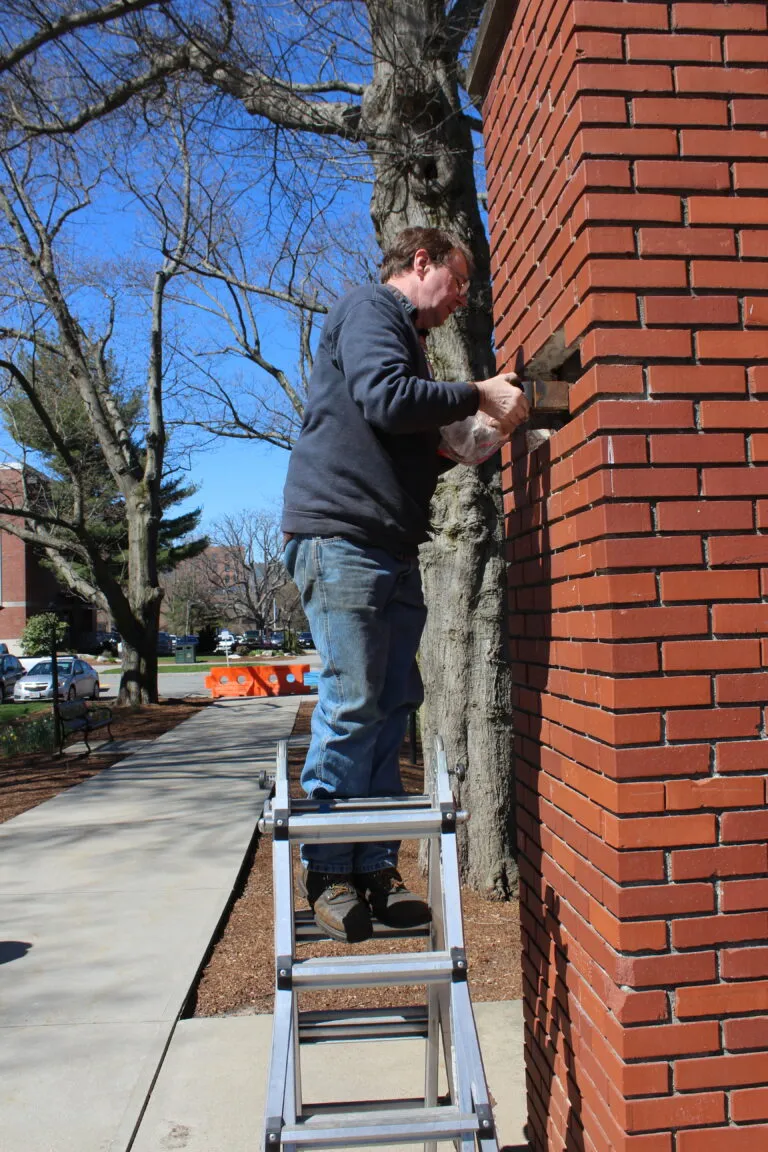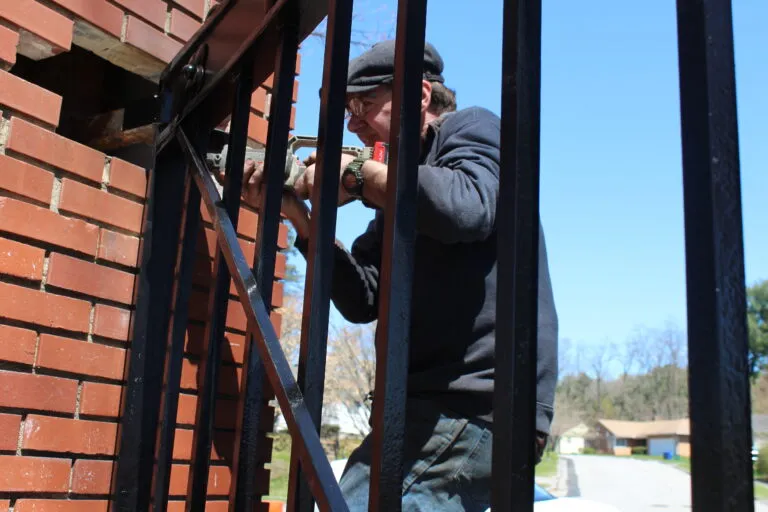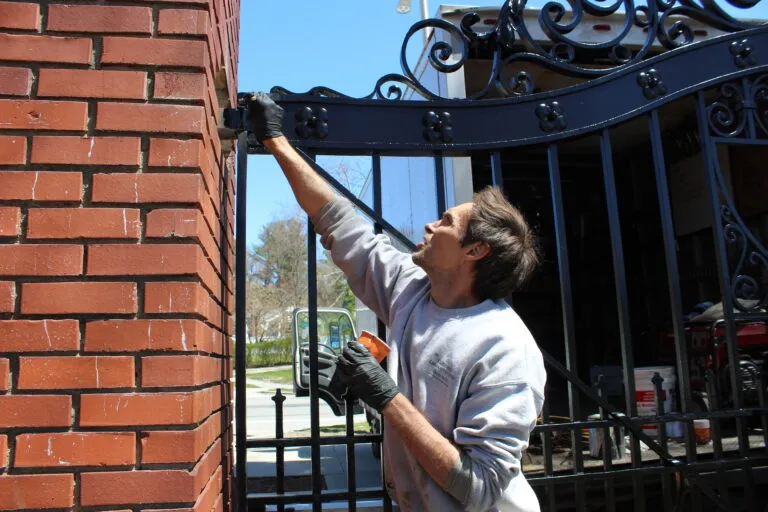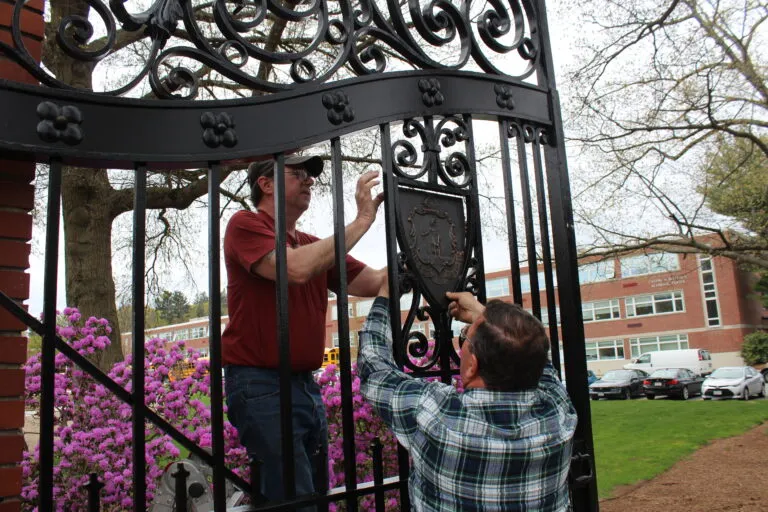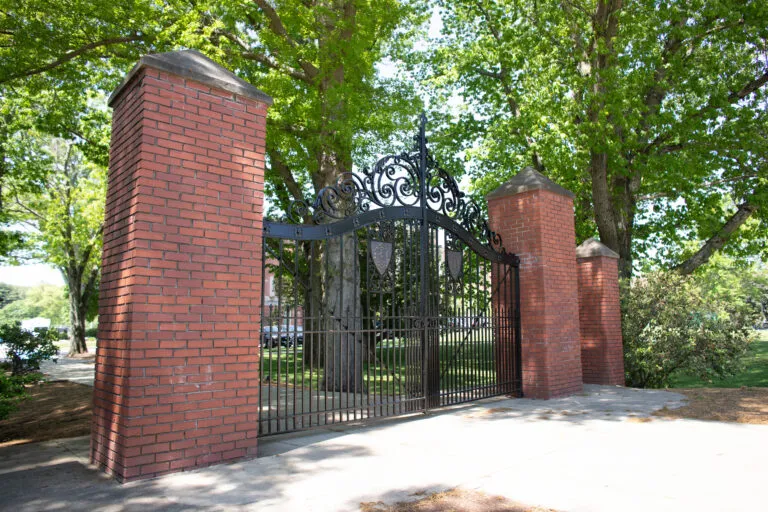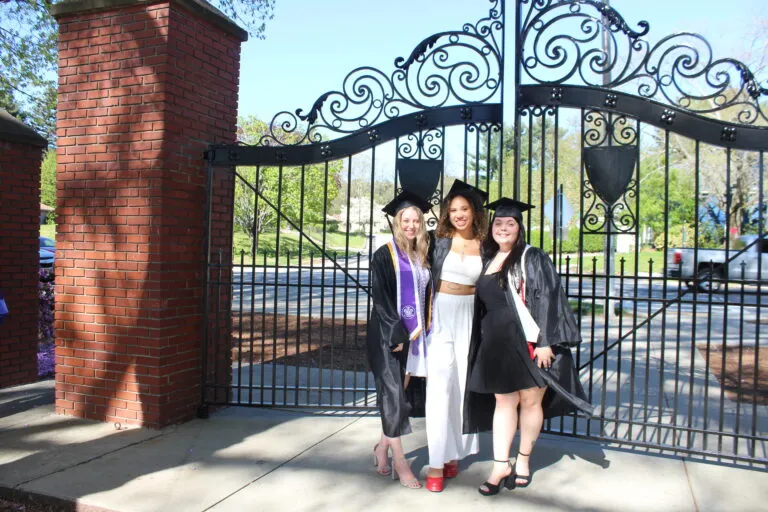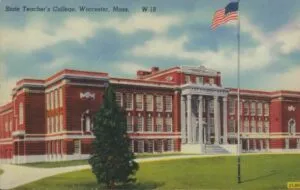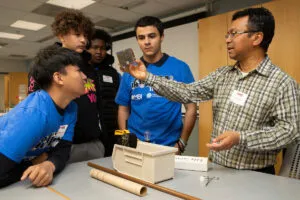Making a Grand Re-entry
Worcester State’s historic Tiffany Gates are restored to their full glory.
As Worcester State University celebrates its 150th anniversary, a restoration project has turned back the hands of time to unveil the magnificence of a university landmark that stands as a testament to the loyalty of its alumni.
In early spring 2024, the university embarked on a project to bring back the glory of its historic Tiffany Gates, the towering 110-year-old wrought iron gates that mark the official entrance to Worcester State.
Installed in 1914 at the Worcester State Normal School on St. Ann’s Hill, the gates were moved to their current spot along Chandler Street when the school relocated to the west side of Worcester in 1932. That year, the school changed its name to Worcester State Teachers College.
“They are a physical link to our origins, and that’s important,” Sandra Olson, assistant vice president for Facilities, Operations, and Planning, said. “There have been countless pictures that graduates in their caps and gowns have taken at those gates with their families. We wanted to preserve that continuity of year after year and class after class enjoying them.”
The graceful gates are a visual centerpiece on campus and a favorite symbol of the university. They have withstood the test of time and are the inspiration for the university’s 150th anniversary logo.
Over time, rust and decay threatened their timeless beauty. Restoration became imperative if the gates were to endure much longer, Olson said. The gates are unusual because not only were they designed by Tiffany, as other iron gates often were, but also they were made by the highly regarded craftsmen in the company’s studios in Corona, Queens, N.Y.
The studios were founded by renowned decorative artist Louis Comfort Tiffany (1848-1933), son of the founder of the famous New York jewelry store. Best known for stained glass, including beautiful art nouveau lamps, Tiffany Studios also produced metalwork including wrought iron, though only for a relatively brief time, which makes the gates even more distinctive.
Restoring them preserves their artistic and cultural value, Olson said, and also ensures their structural integrity and longevity.
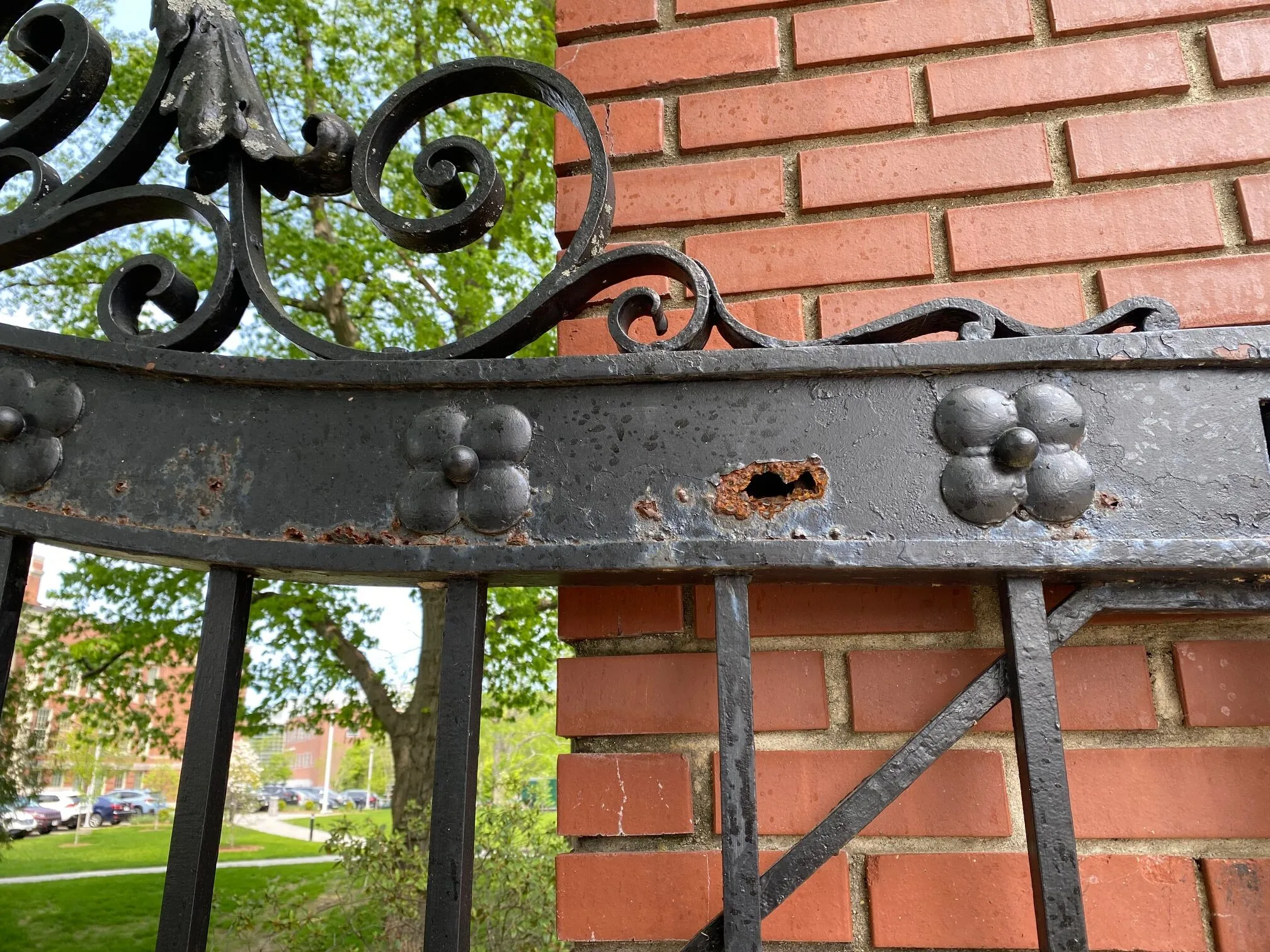
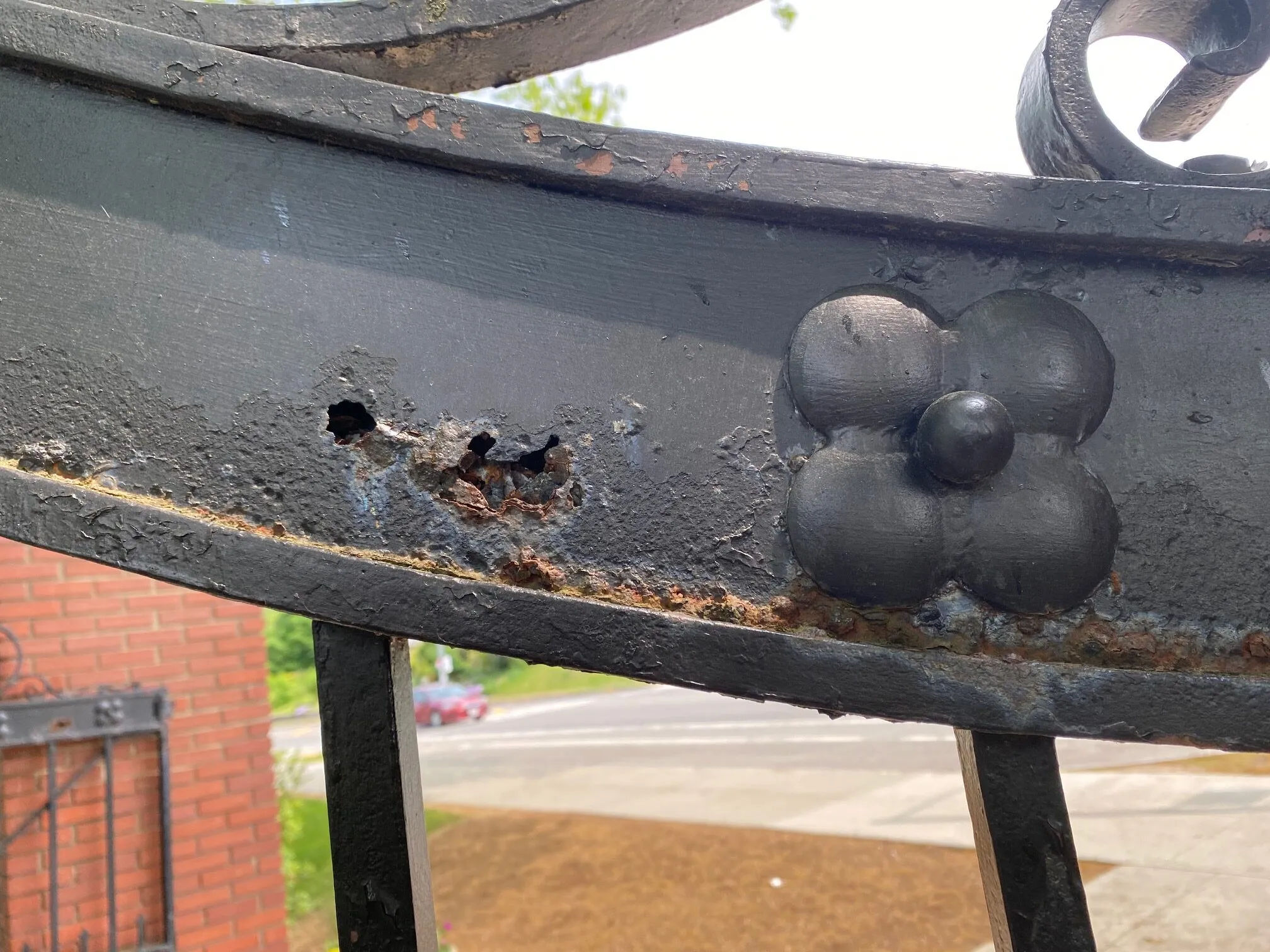

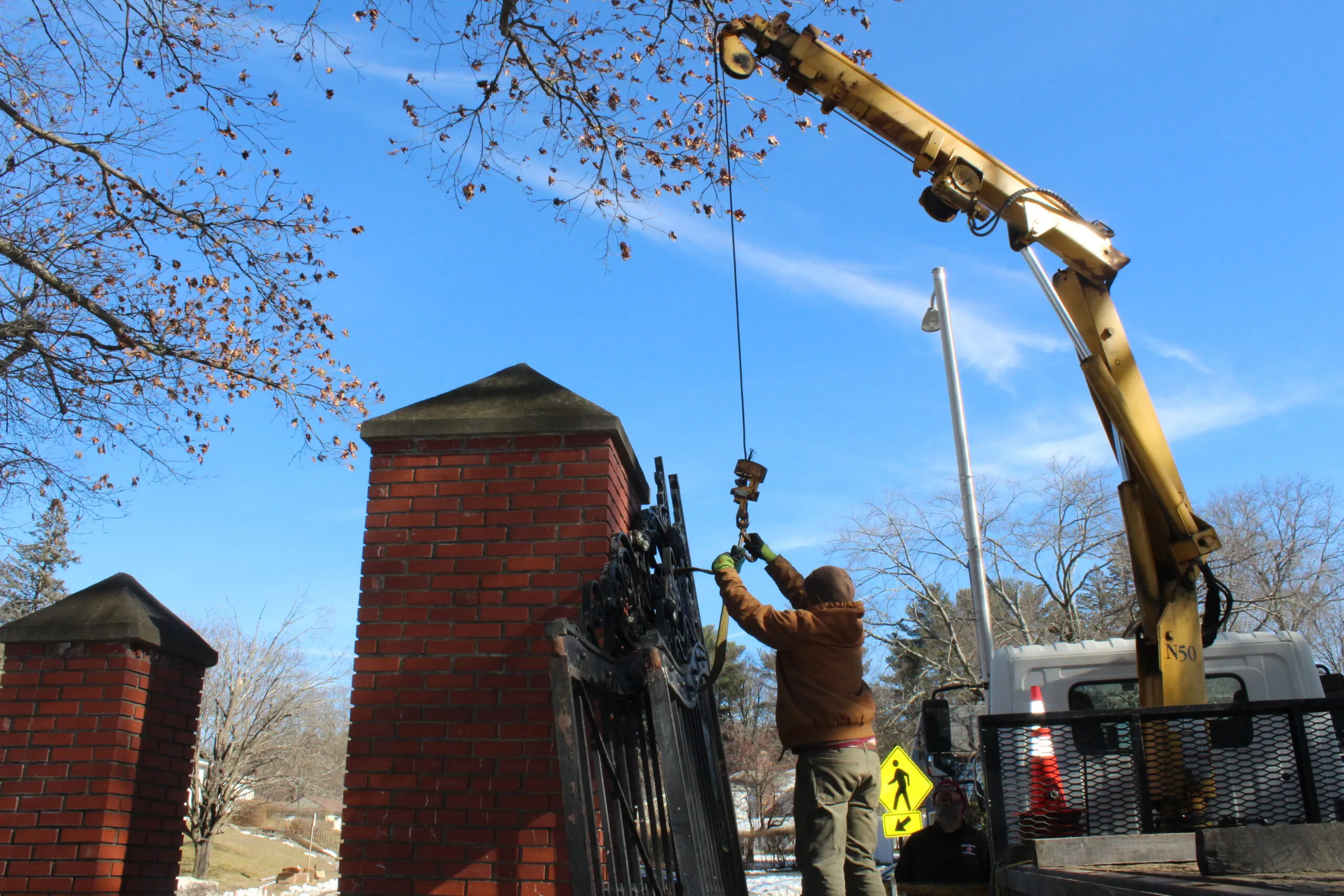
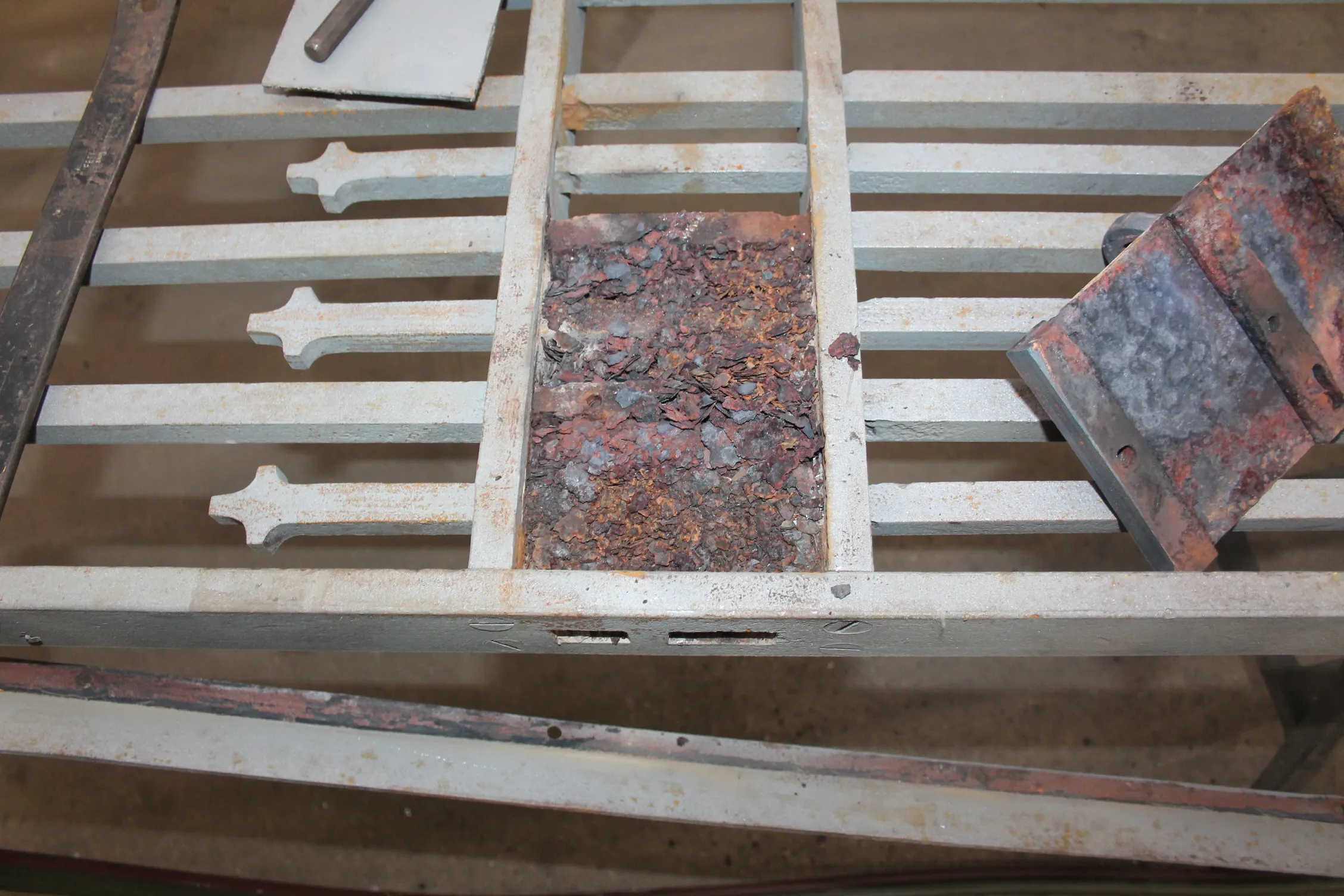
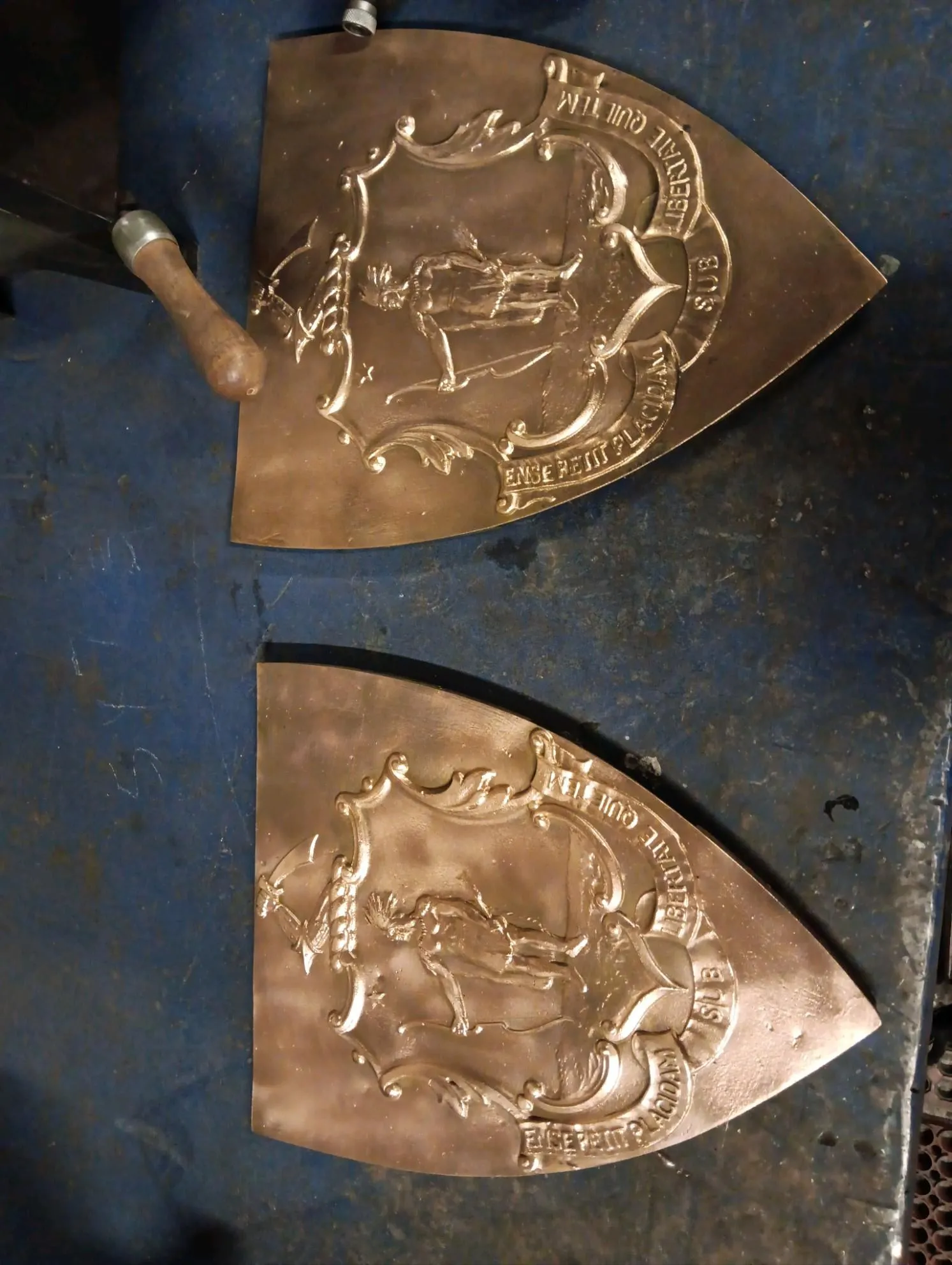
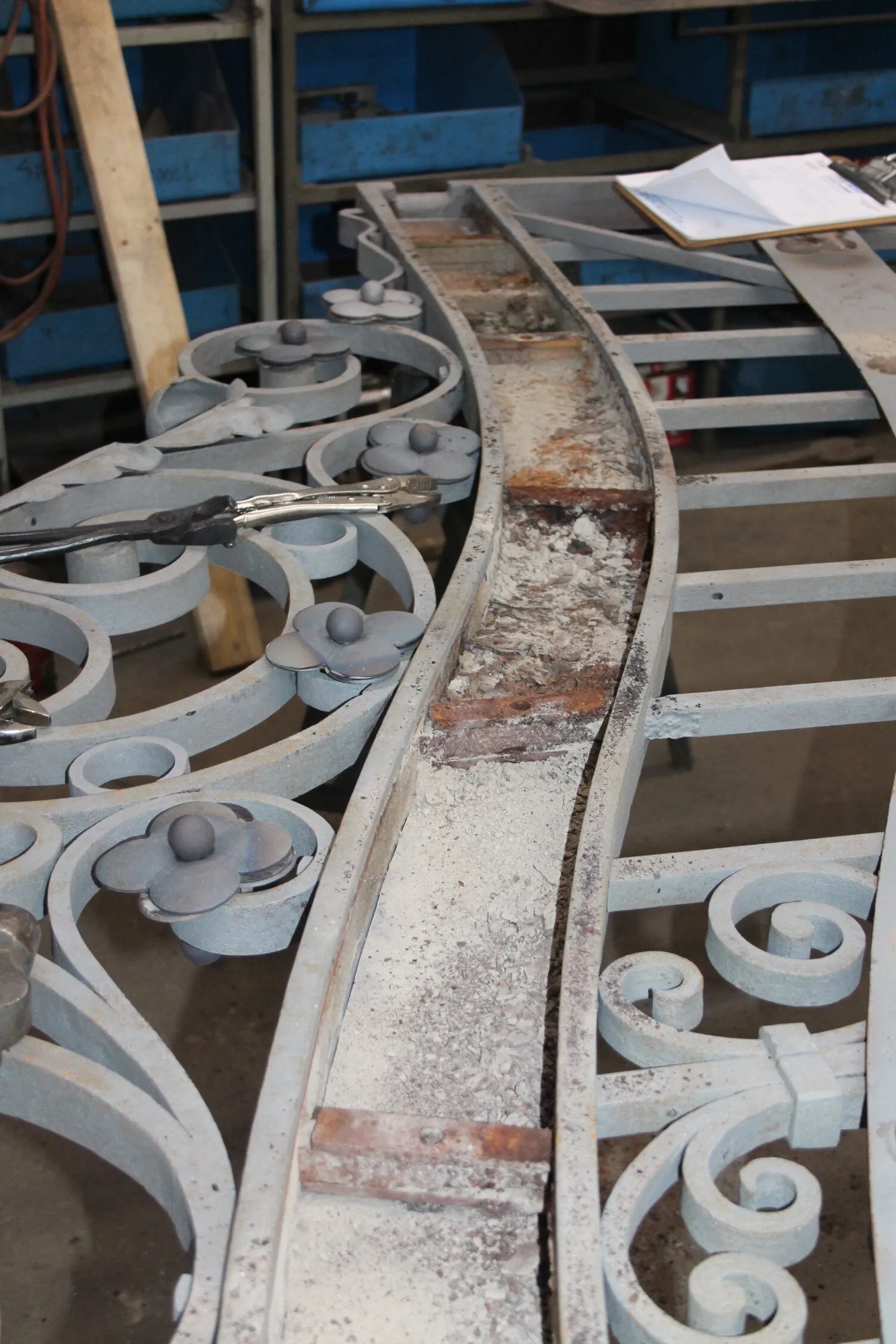
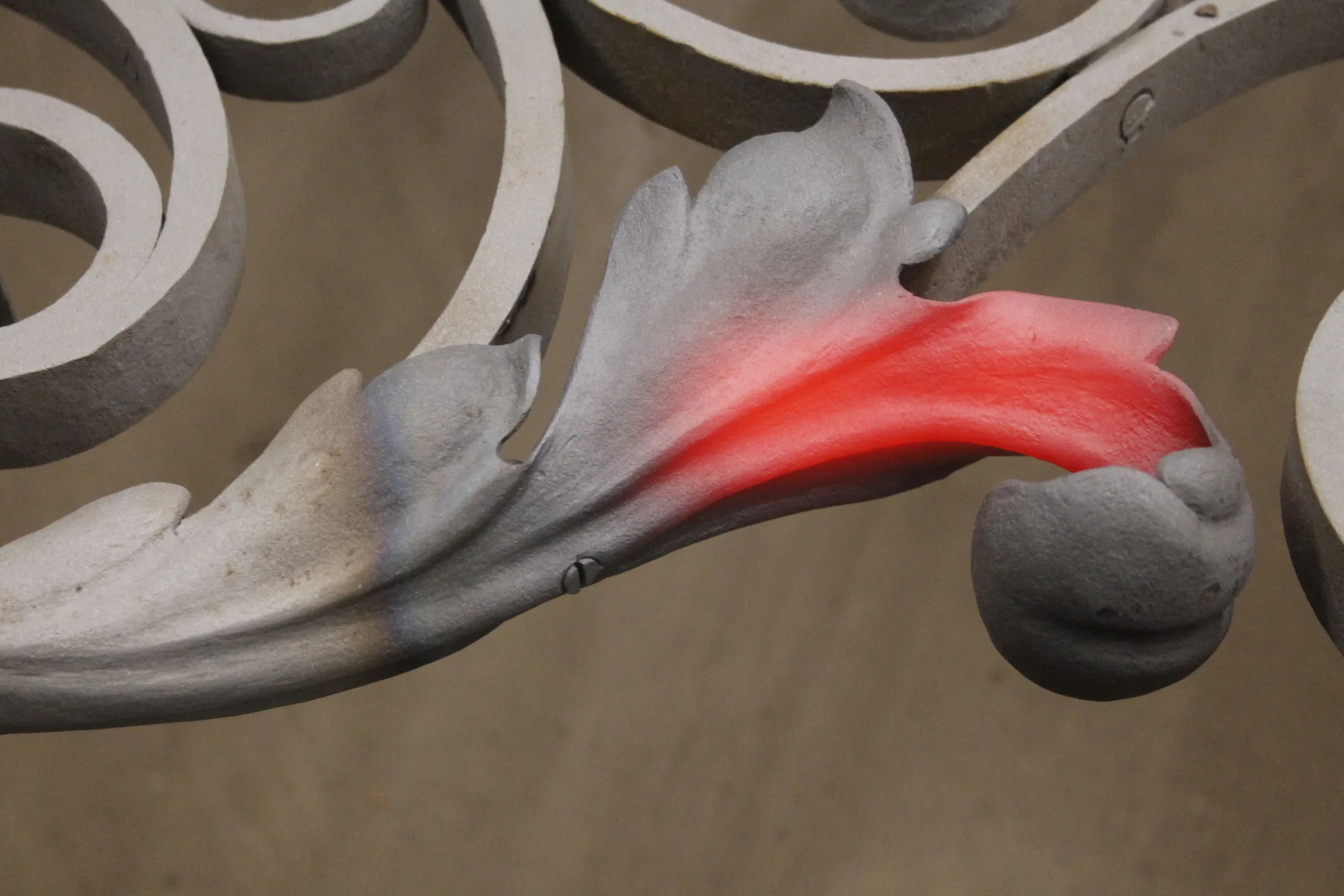
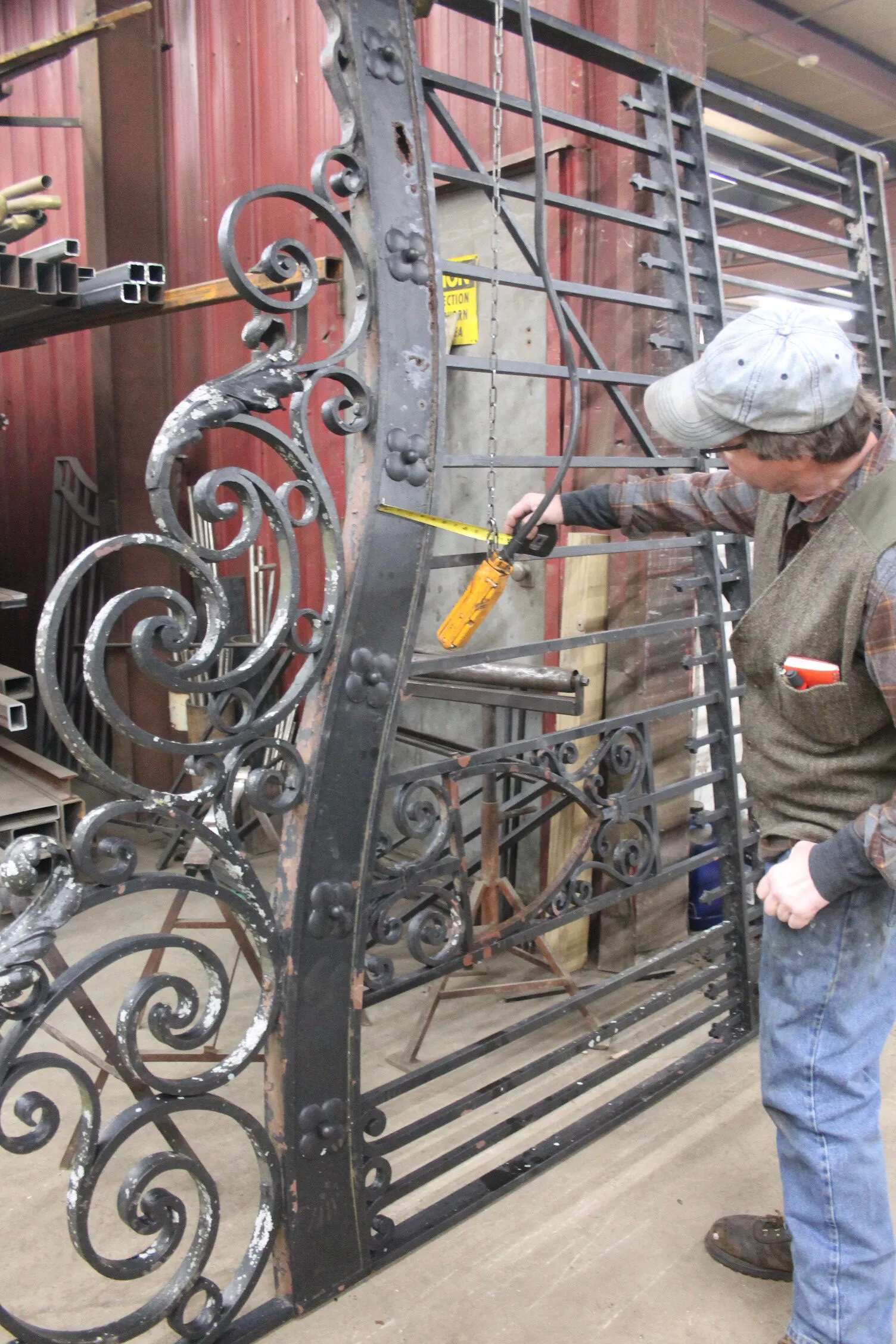
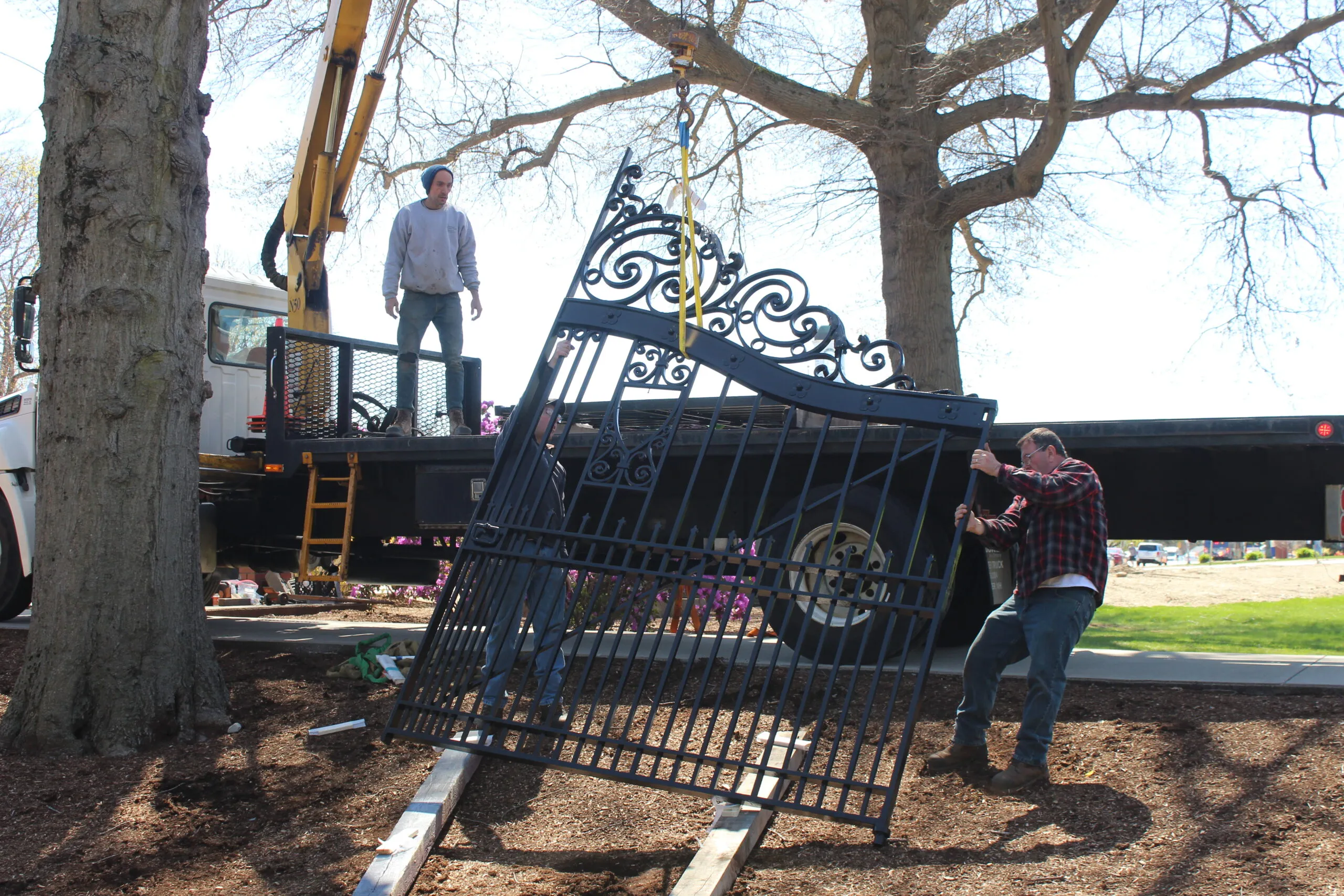
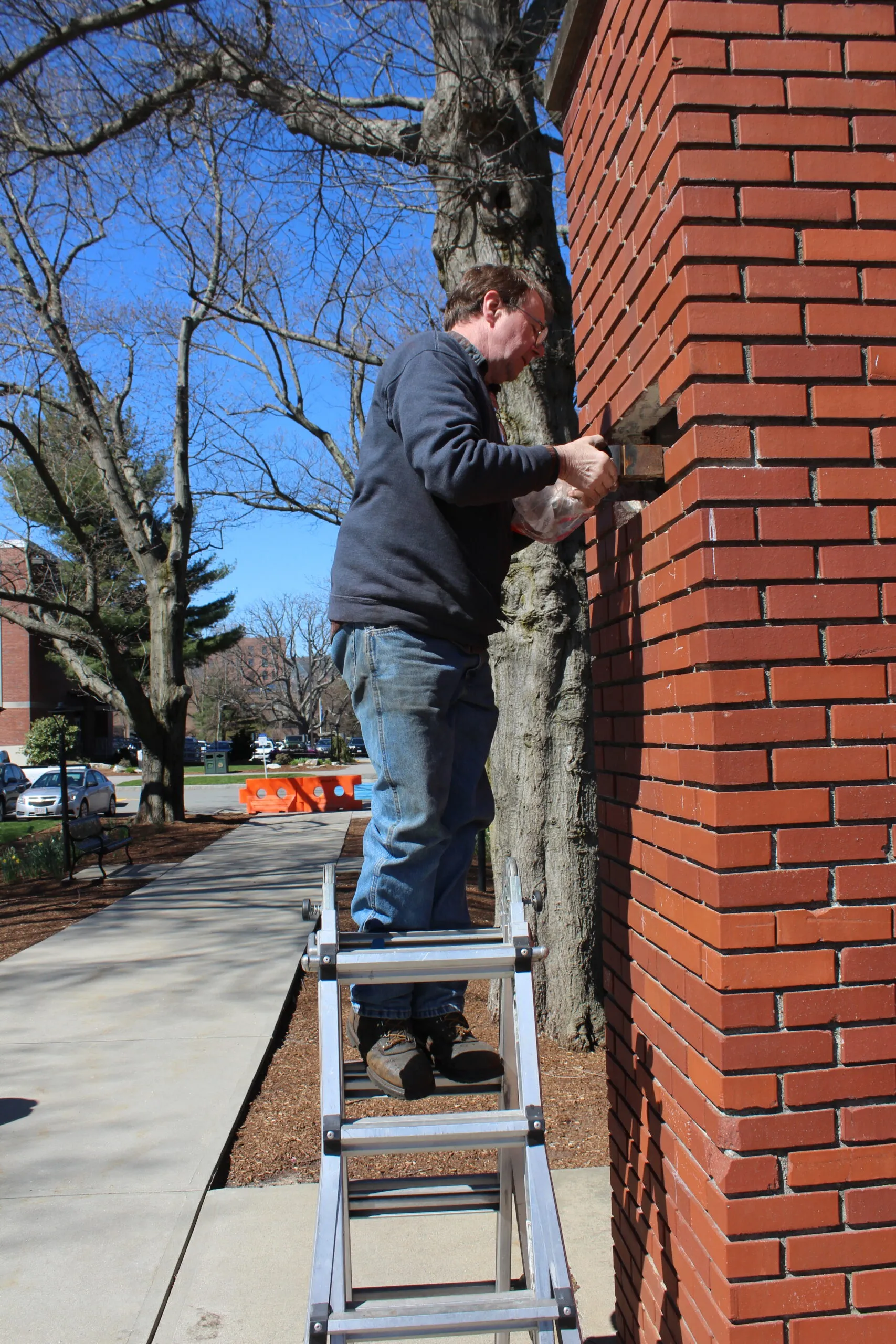
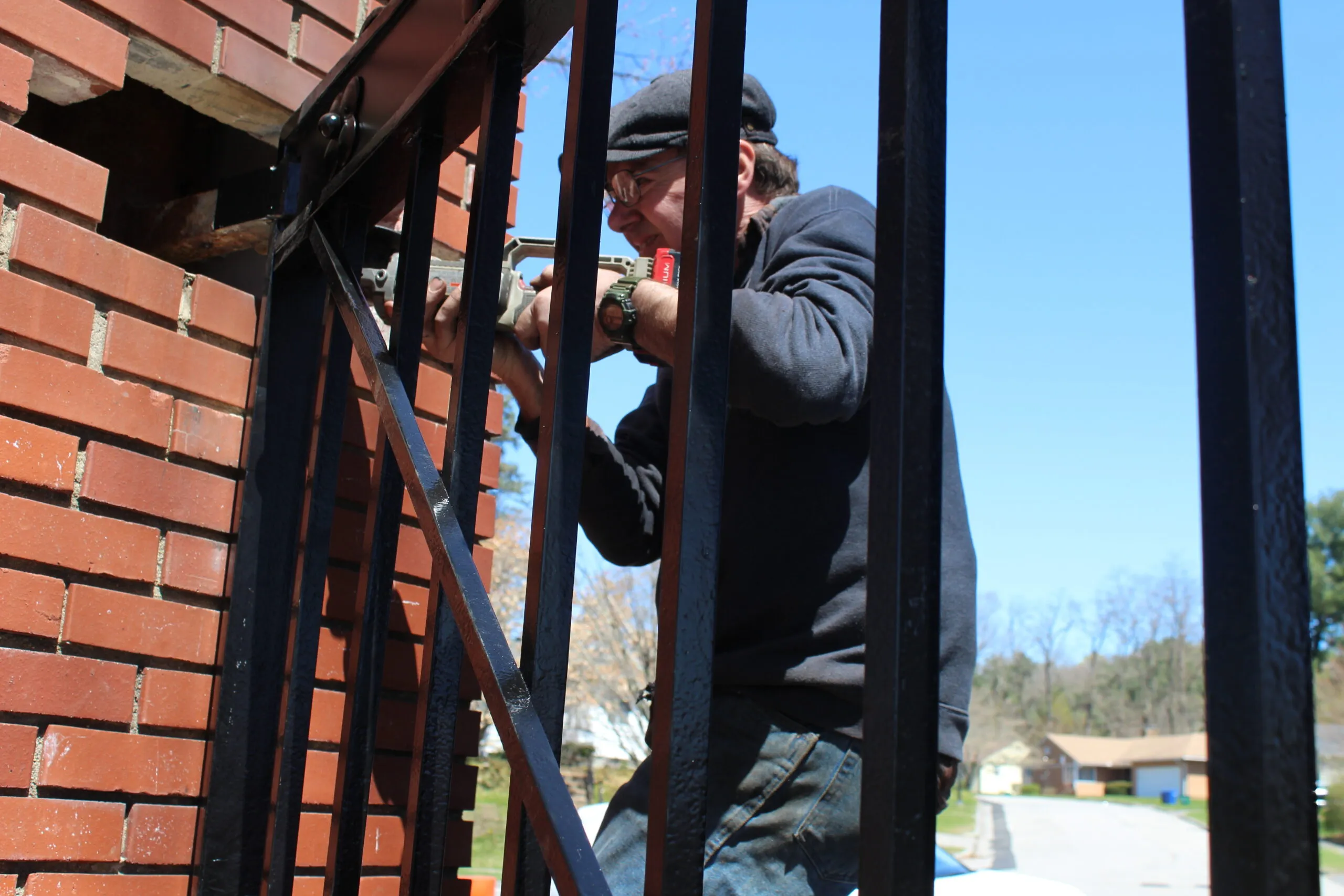
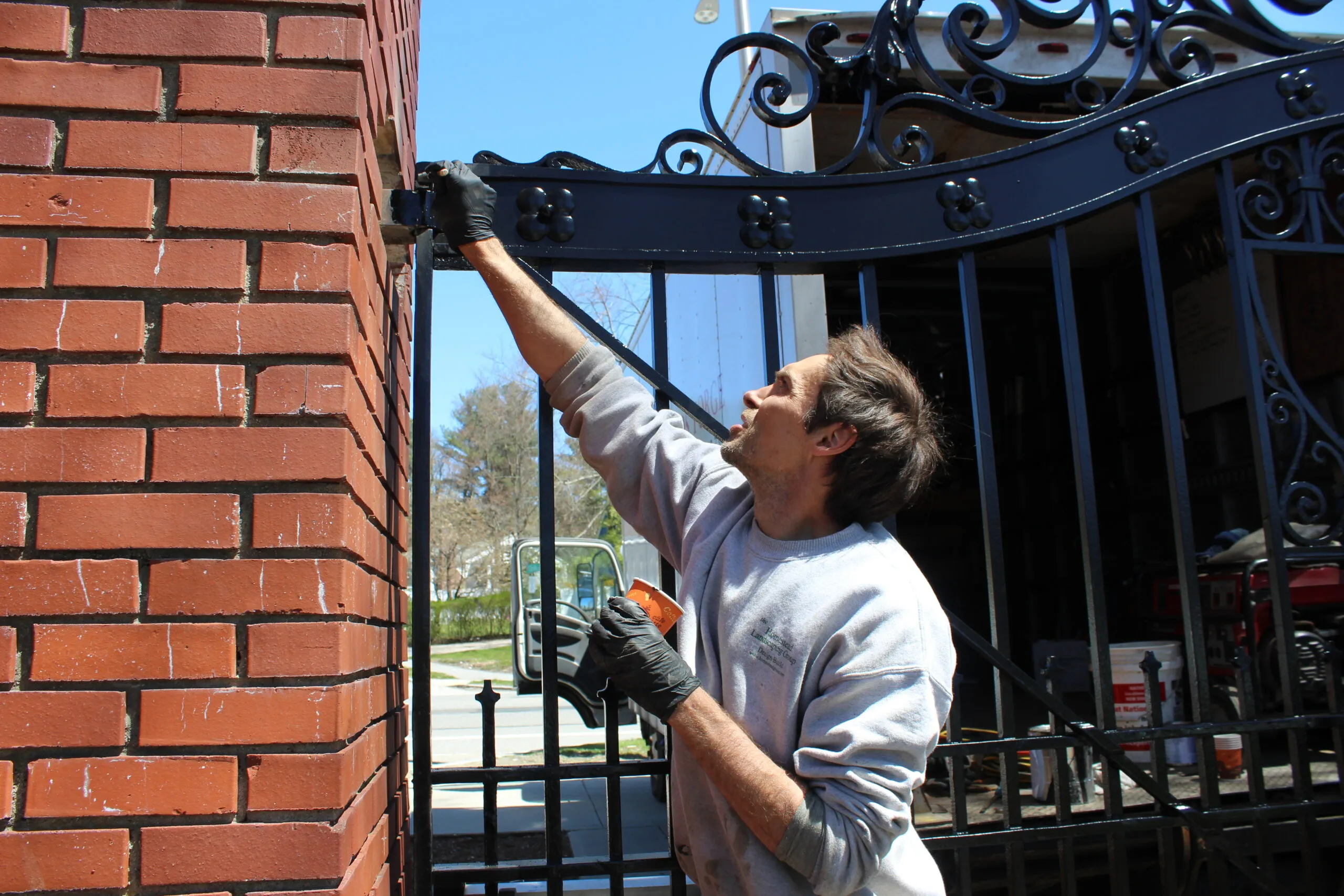
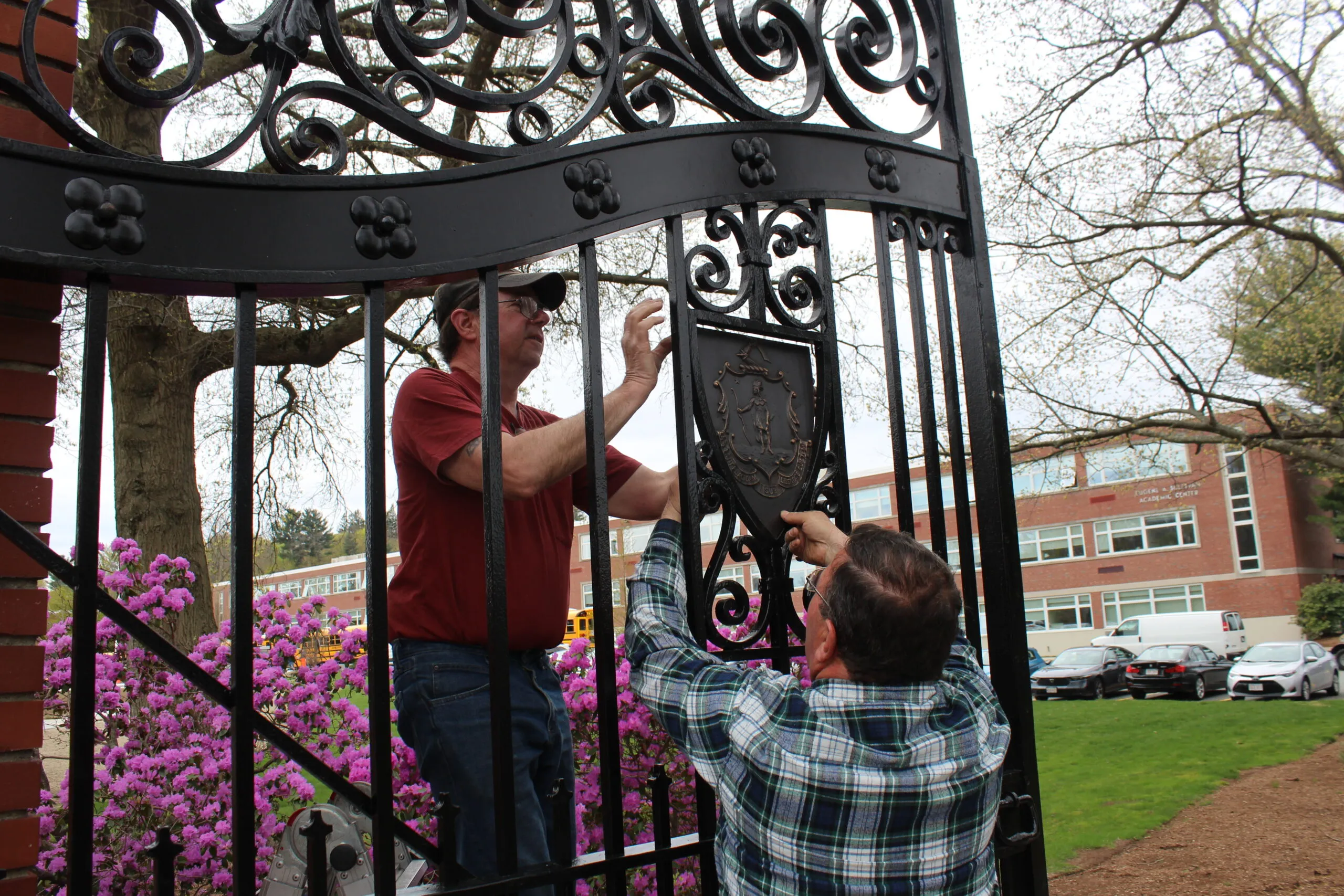
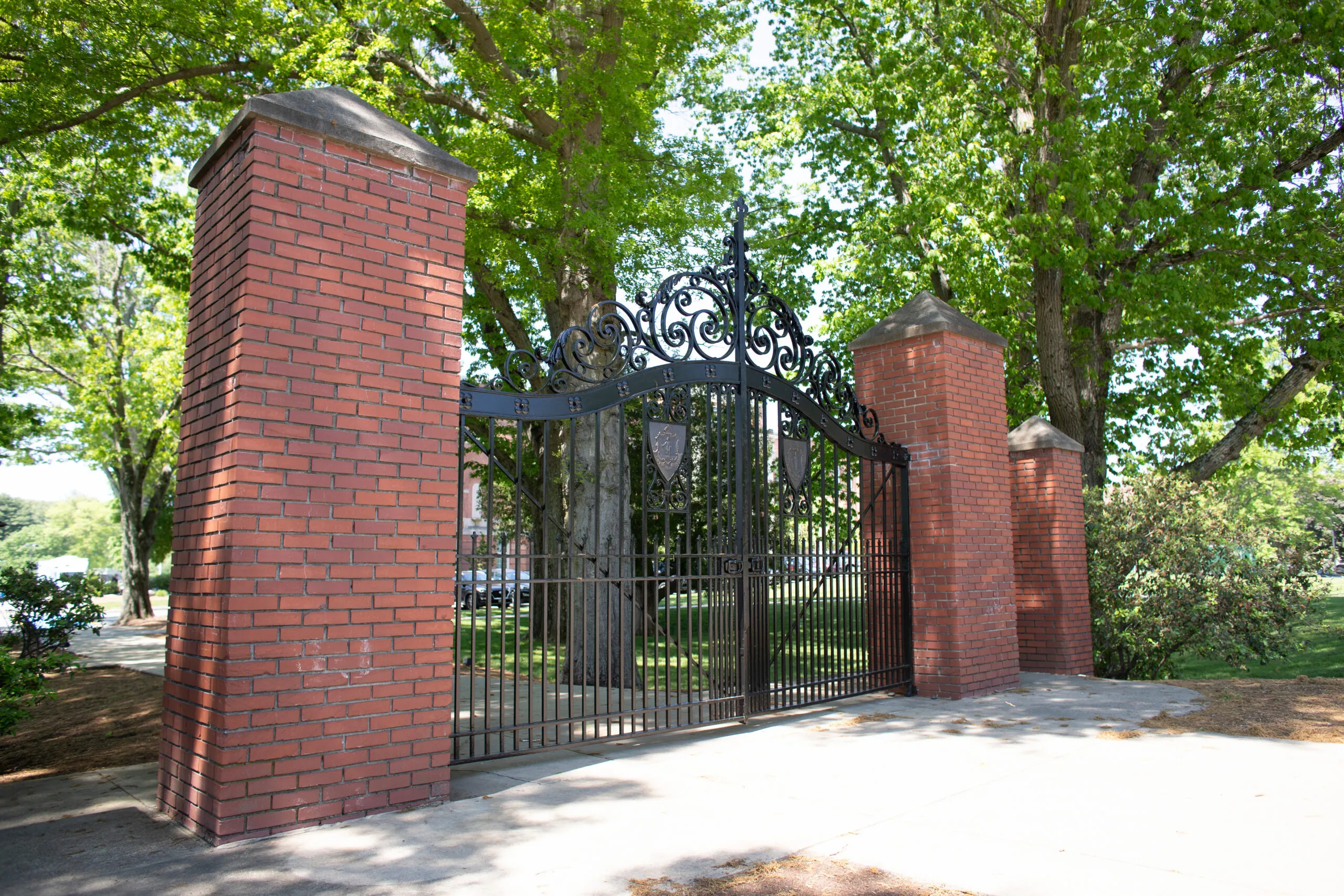
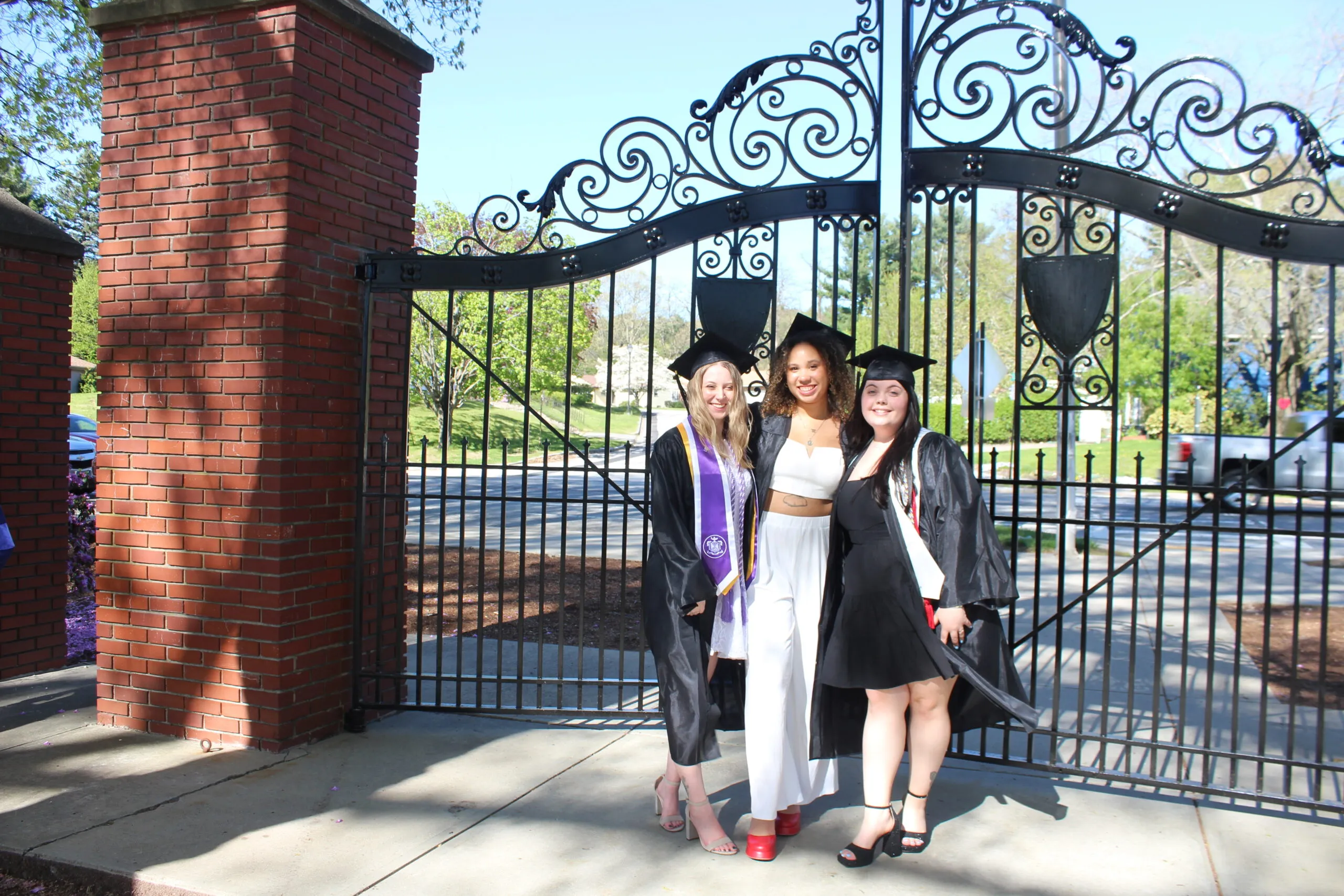
After a lengthy search, the university last spring turned to Hammersmith Studios of Canton, Mass., a highly regarded metalworking firm, to breathe new life into these gatekeepers of history.
Olson chose Hammersmith because she wanted a restoration company that had experience working on similar projects, and Hammersmith had an outstanding reputation for their ironwork for prestigious institutions like Harvard and Yale. Their special expertise made them the right choice for the restoration project, she said.
“It was important to fi nd a restoration company that understood the value and craftsmanship of the gates and would be able to restore them to their original condition,” she said.
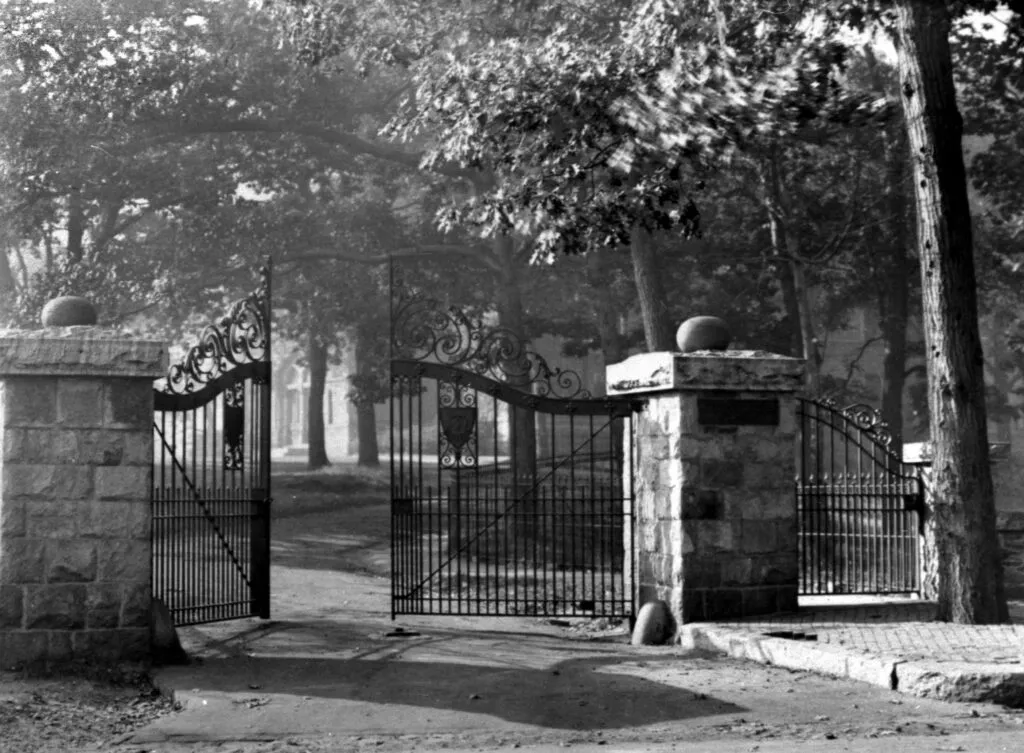
At a cost of $1,100, the gates were a gift of the Worcester Normal School’s Graduates’ Association, an alumni organization that launched a fundraising eff ort in 1911, according to a history of the association in the university’s archives. At a meeting of the class secretaries on March 25, 1911, it was decided that adding iron gates to the campus, as was the style at other institutions of higher education back then, would be a fitting way for the graduates to express their gratitude to their alma mater.
Once that decision was made, a fundraising letter was sent to association members, stating in part:
The northeast entrance to the grounds is the approach used by all comers by car, by carriage, or by automobile, and in the case of a stranger the first impression of the institution is gained at this place.
A handsome gateway there, to cost in the neighborhood of a thousand dollars, would add greatly to the dignity and attractiveness of the grounds; if it grounds; if it should be placed there by the alumni and suitably inscribed it would stand as long as the school endures, a proof of the generous devotion of the graduate body.
We number almost fourteen hundred loyal souls, and the experience of the past indicates that they will rally to the support of their Alma Mater… A contribution of a dollar from every member would provide, and more, the necessary amount… Let us all put our shoulders to the wheel.
They finally reached the required sum and even went beyond it, with $1,120.78 raised. There were many delays before the order could be satisfactorily placed, however, and then there were unexpected difficulties setting up the gates, the Association history states.
So, although the tablet posted at the gates bears the date 1913, it was really the spring of 1914 before they were in place, and their presentation was made part of the exercises of the 40th anniversary celebration that September.
At the dedication, Miss Arabella Tucker, a founding faculty member who graduated from Worcester Normal School in 1876 and served as secretary of the Graduates’ Association, described the gates as the college’s “everlasting doors.” She urged then-principal William B. Aspinwall to guard well the gates in service to mankind, according to a 1975 newspaper article written by the late Professor Emeritus Robert F. McGraw ’63, who taught history at Worcester State until 1991.
By 1974, the gates had been damaged by a snowplow and were in need of repair. The Alumni Association under the leadership of political science professor David Twiss led a fundraising effort as part of the school’s 100th anniversary, and the gates were repaired and reinstalled in 1975.
“Today a whole new Worcester State exists, growing, vigorous, and optimistic,” McGraw wrote. “Much has changed, yet as the gates symbolize, much remains. The gates once more stand proudly as the formal entrance to the college and the world of learning.… More, they are visible proof that the alumni promise of old, that the gates shall stand evermore, has been fulfilled.”
As the university looked ahead to its 150th anniversary, the gates were again in need of restoration and preservation to maintain their intrinsic value to the university, and by last spring the project could no longer be delayed, Olson said. About 17 years ago, Olson invited the international auction and appraisal firm Skinner & Co. to inspect the gates. Skinner said it would cost somewhere between $26,000 or $56,000 to replace them. However, Olson said the value of the gates is not in their monetary worth, but in their historical and sentimental value as the first alumni gift to the institution.
The Hammersmith team working to restore the gates was led by master blacksmith Carl Close Jr., who said he appreciated their historical significance and the provenance of Tiffany Studios. “Tiffany started the iron part of their business around 1910, and these were completed in 1914, so it was fairly early in their career,” he said. “They stopped making ironwork in the 1930s during the Depression after Tiffany developed health problems and passed away, so they are fairly rare.”
Close said he approaches the restoration process by trying to understand a piece’s original craftsmanship. “First, I try to get inside the head of the person who made it, and from there, you can kind of reverse engineer it with the repairs to get it back to the way it was when they first made it. I’ve developed a good feeling for it just from doing this type of work for almost 40 years and seeing a lot of old ironwork and how it was made.”
The gates needed a lot of work to restore their structural integrity and ensure their longevity, Close said. The consequences of decades of water infiltration was one of the main challenges Hammersmith faced. The water had made its way inside the gates where extensive rusting had created large holes in some areas. The rust was so severe in spots that only the many coats of paint that had been applied over the years were holding parts together.
“It’s like if you owned a 1972 Buick, and over the wheel wells, it looks okay, but you put your finger on it, and it actually goes through it. That’s kind of the way it was with these in places,” Close said.
The biggest surprise, perhaps, was damage from animals: birds and other critters had made nests inside the gates, and the acids and salts from their waste further damaged the metal.
“It’s almost like opening an onion,” Close said. “You start to see all the layers of paint and repairs and things that shouldn’t have been done, and finally when you get to the bottom of it, you see where the real problem was, and most of the time it’s because of water infiltration and delayed maintenance.”
Water and other environmental factors accelerate the natural tendency of metals to revert over time to the ores they originally were before being transformed in the forging process, he said. “Most of the time when you start repairing things, you notice that the problems are caused by the environment because metal naturally wants to turn back into dust,” he said.
That natural process of decomposition over time now has been set back a hundred years by the restoration project. The Tiffany gates have been restored and were reinstalled in April 2024 in time for spring Commencement.
“This restoration project is a testament to Worcester State’s commitment to preserving its rich history and heritage,” Olson said. “The gates have been restored to their former glory, ensuring their preservation for future generations.”

